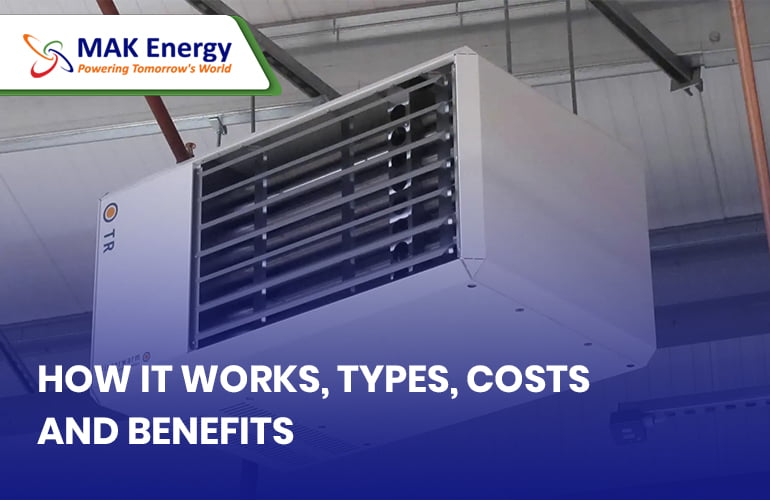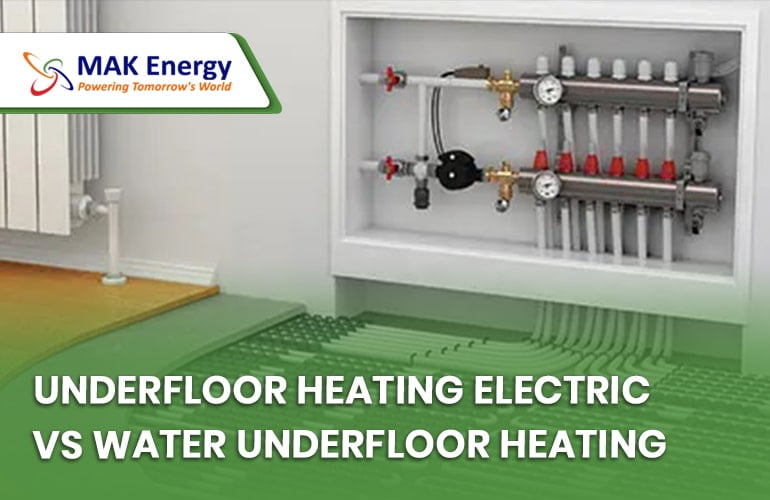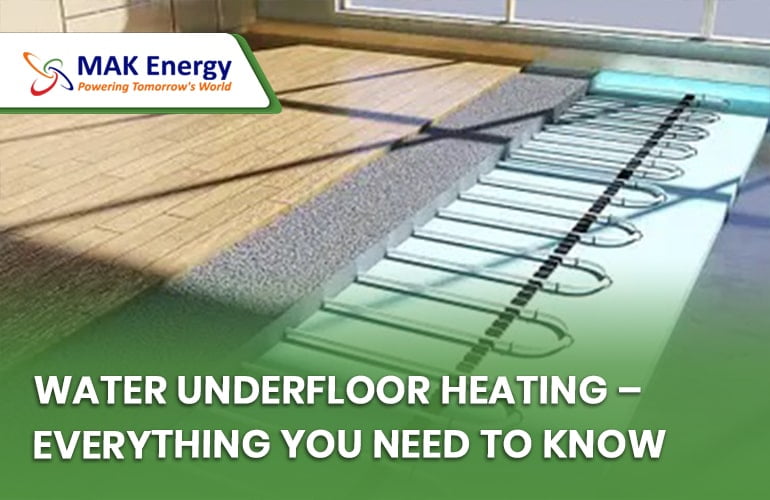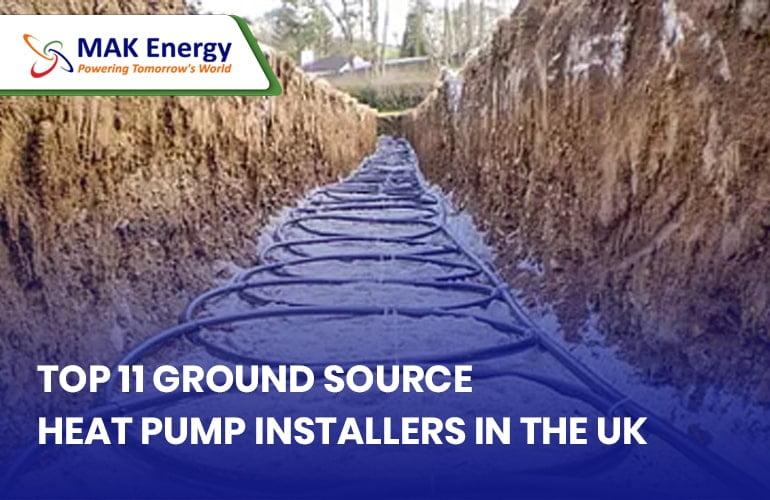Last updated: January 11th, 2024 at 07:10 am
Are you tired of feeling chilly in your home during the winter months? If so, it may be time to consider a warm air heating system. This type of heating system is a popular choice among homeowners for its efficient and effective heating capabilities. In this article, we’ll take a closer look at how warm air heating systems work and the benefits they offer.
- What is a Warm Air Heating System?
- How Does a Warm Air Heating System Work?
- Types of Warm Air Heating System: Comparison
- Benefits of a Warm Air Heating System
- Conclusion
What is a Warm Air Heating System?
A warm air heating system is a type of central heating system that uses air to distribute heat throughout a building. This system is made up of a furnace, a heat exchanger, and a duct system. The furnace is responsible for heating the air, while the heat exchanger transfers the heat from the furnace to the air. The duct system then distributes the heated air throughout the building.
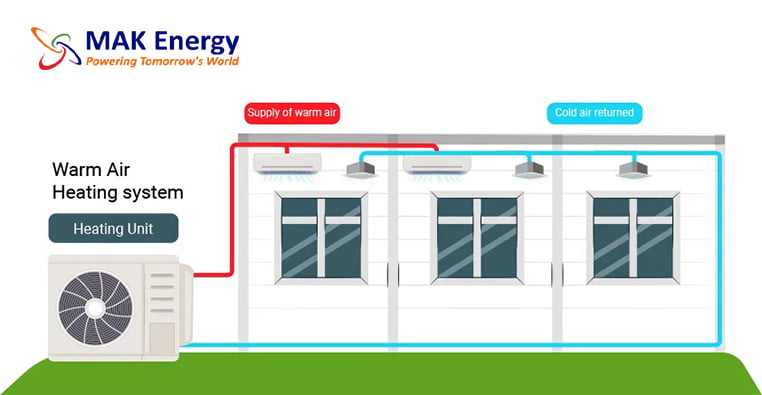
How Does a Warm Air Heating System Work?
A warm air heating system works by using a furnace to heat air, which is then distributed throughout the building via a duct system. The furnace can be fueled by natural gas, oil, or electricity. When the furnace is turned on, the fuel is burned, which creates heat. This heat is then transferred to the air by the heat exchanger.
The warm air is then distributed throughout the building via a duct system. The duct system is made up of a network of ducts that run through the walls, floors, and ceilings of the building. The warm air is blown through these ducts and into the rooms of the building.
Types of Warm Air Heating System: Comparison
There are several different types of warm air heating systems, each with its own unique features and benefits. Here are the most common types of warm air heating systems:
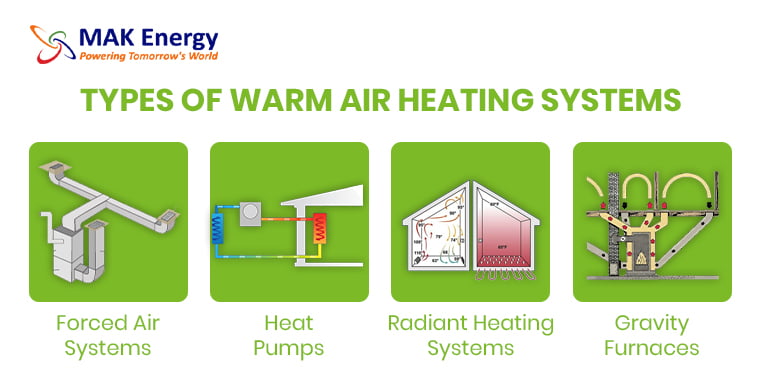
Forced Air Systems
Forced air heating systems are the most common type of warm air heating system. These systems use a furnace to heat the air, which is then blown through ductwork and distributed throughout the building. Forced air systems are known for their quick and efficient heating capabilities, making them a popular choice for many homeowners.
Heat Pumps
Heat pumps are another type of warm air heating system. These systems work by extracting heat from the outside air and using it to heat the building. In the summer, the process is reversed, and the heat pump can be used for air conditioning. Heat pumps are known for their energy efficiency, making them a popular choice for homeowners who are looking to save money on their energy bills.
1 – Air-Source Heat Pumps
Air-source heat pumps extract heat from the outdoor air and transfer it indoors to heat a building during colder months. They can also work in reverse during warmer months to provide cooling. Air-source heat pumps are the most common type of heat pump and can be further categorized into two subtypes:
1 – Air-to-Air Heat Pumps
These heat pumps transfer heat between the outdoor air and indoor air through ductwork or air handlers. They are suitable for both residential and commercial applications.
2 – Air-to-Water Heat Pumps
These heat pumps transfer heat from the outdoor air to a hydronic system, such as underfloor heating or radiators, to provide heating for the building.
2 – Ground-Source Heat Pumps (Geothermal Heat Pumps)
Ground-source heat pumps extract heat from the ground or a water source, such as a well or pond, and transfer it indoors. They utilize the relatively constant temperature of the ground to provide efficient heating and cooling. Ground-source heat pumps can be further divided into two sub types:
1 – Closed-Loop Systems
These systems circulate a fluid (usually water or a mixture of water and antifreeze) through a closed loop of underground pipes or loops buried horizontally or vertically. They exchange heat with the ground through the pipe loop.
2 – Open-Loop Systems
These systems use groundwater or surface water as a heat exchange medium. They pump water from a well or other water source, extract heat from it, and then discharge the water back into the environment.
3- Water-Source Heat Pumps
Water-source heat pumps extract heat from a water source, such as a lake, river, or well, and transfer it indoors. Similar to ground-source heat pumps, water-source heat pumps utilize the relatively constant temperature of the water source for efficient heating and cooling. These heat pumps are commonly used in larger commercial buildings that have access to a nearby water source.
4 – Hybrid heat pumps
Hybrid heat pumps, also known as dual-fuel heat pumps, are a type of heating and cooling system that combines the benefits of both an air-source heat pump and a fossil fuel-powered backup system, typically a gas furnace. This combination allows the system to optimize energy efficiency and provide reliable heating and cooling performance. The primary component of a hybrid heat pump is the air-source heat pump, which operates as the primary heating and cooling source. It extracts heat from the outdoor air during the heating season to warm the indoor space and reverses the process during the cooling season to provide air conditioning. Air-source heat pumps are highly efficient in moderate climates, but their efficiency may decrease in very cold temperatures.
Each type of heat pump has its own advantages, disadvantages, and considerations in terms of installation requirements, efficiency, cost, and suitability for different climates. Factors such as the availability of outdoor space, the presence of a water source, and the heating and cooling needs of the building should be taken into account when selecting the appropriate type of heat pump. Consulting with HVAC professionals can provide further guidance in choosing the most suitable heat pump type for a specific application.
Radiant Heating Systems
Radiant heating systems work by using hot water or electric coils to heat a building. The heat is then radiated from the heating source to the objects in the room, providing a more even and comfortable heat. Radiant heating systems are often used in conjunction with other heating systems, such as forced air systems, to provide more consistent and efficient heating.

Gravity Furnaces
Gravity furnaces are an older type of warm air heating system that uses the natural convection of warm air to distribute heat throughout a building. These systems rely on a large, central furnace that is typically located in the basement or crawlspace of the building. The warm air rises from the furnace and is distributed through duct-work to the rooms above. While gravity furnaces are not as efficient as other types of warm air heating systems, they can be a good option for older homes with limited space for duct-work.
Benefits of a Warm Air Heating System
Efficient Heating
One of the main benefits of a warm air heating system is its efficient heating capabilities. Warm air systems can heat a building quickly and evenly, which means that you won’t have to wait long to feel the effects of the heat. Additionally, warm air heating systems can be more energy-efficient than other types of heating systems, such as radiators.
Cost-Effective
Another benefit of a warm air heating system is that it can be cost-effective. Warm air systems can be less expensive to install than other types of heating systems, such as radiant heating systems. Additionally, because warm air systems can heat a building quickly and evenly, you may be able to use the system less often than other types of heating systems, which can help you save money on your energy bills.
Improved Air Quality
Warm air heating systems can also improve the air quality in your home. Because warm air systems use a filter to clean the air before it is distributed throughout the building, they can help remove dust, dirt, and other allergens from the air.
Versatility
Warm air heating systems can be used in a variety of different types of buildings, including homes, offices, and commercial buildings. Additionally, because warm air systems can be fueled by natural gas, oil, or electricity, they can be used in areas where other types of heating systems may not be practical.
Ease of Use
Finally, warm air heating systems are typically very easy to use. Once the system is installed, you simply need to turn it on to enjoy warm, comfortable air throughout your building. Additionally, many modern warm air heating systems come with programmable thermostats, which allow you to set the temperature of your building to your preferred level.
What is the Cost of Installing Different Warm Air Heating Systems in the UK?
The cost of installing a warm air heating system in the UK can vary depending on a number of factors, including the type of system you choose, the size of your home or building, and the complexity of the installation. Here is a rough guide to the cost of installing some of the most common types of warm air heating systems in the UK:
1 – Forced Air Systems Costs
The cost of installing a forced air heating system in the UK can range from £2,500 to £5,000 or more, depending on the size of your home or building and the complexity of the installation. This cost typically includes the installation of the furnace, ductwork, and other necessary components.
2 – Heat Pumps Costs
The cost of installing a heat pump in the UK can range from £6,000 to £12,000 or more, depending on the size of your home or building and the complexity of the installation. This cost typically includes the installation of the heat pump, duct work or other necessary components.
1 – Air Source Heat Pumps Costs:
1 – Air-to-Air Heat Pumps Cost:
The cost of air-to-air heat pumps in the UK typically ranges from £3,000 to £8,000, including installation.
2 – Air-to-Water Heat Pumps Cost:
The cost of air-to-water heat pumps in the UK generally ranges from £6,000 to £12,000, including installation.
2 – Ground Source Heat Pumps (Geothermal Heat Pumps) Costs:
1 – Closed-Loop Systems:
The cost of closed-loop ground-source heat pump systems in the UK usually starts from £10,000 and can go up to £20,000 or more, depending on the system size and installation requirements.
2 – Open-Loop Systems:
The cost of open-loop ground-source heat pump systems in the UK typically starts from £15,000 and can go up significantly depending on factors such as the water source availability and drilling requirements.
3- Water Source Heat Pumps:
The cost of water-source heat pumps in the UK varies depending on factors such as the water source availability, system size, and installation requirements. As such, it is recommended to consult with HVAC professionals to get accurate cost estimates specific to your project.
4 – Hybrid Heat Pump
The cost of hybrid heat pumps in the UK typically ranges from £8,000 to £15,000 or more, including installation. This cost range is an estimate and can vary depending on the specific requirements of your property, such as the size of the system and any additional installation considerations.
3 – Radiant Heating Systems Costs
The cost of installing a radiant heating system in the UK can range from £6,000 to £12,000 or more, depending on the size of your home or building and the complexity of the installation. This cost typically includes the installation of the heating source, whether it be hot water or electric coils, and the necessary components to distribute the heat, such as pipes or wiring.
4 – Gravity Furnaces Costs
The cost of installing a gravity furnace in the UK can range from £2,500 to £4,000 or more, depending on the size of your home or building and the complexity of the installation. This cost typically includes the installation of the furnace and the necessary duct work.
It’s worth noting that these costs are just estimates, and the actual cost of installing a warm air heating system can vary depending on your specific situation. Additionally, ongoing maintenance and repairs should also be factored into the overall cost of owning a warm air heating system. To get a more accurate idea of the cost of installing a warm air heating system in your home or building, it’s best to consult with a qualified HVAC technician who can provide a detailed quote based on your specific needs and requirements.
Conclusion
Overall, a warm air heating system can be an excellent choice for homeowners who are looking for an efficient, cost-effective, and versatile heating system. Whether you’re looking to heat your home, office, or commercial building, a warm air heating system can provide you with the warmth and comfort you need during the cold winter months. By understanding how these systems work and the benefits they offer, you can make an informed decision about whether a warm air heating system is right for you.

